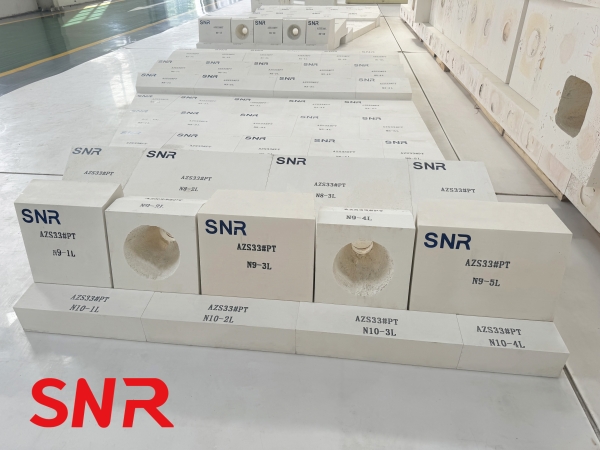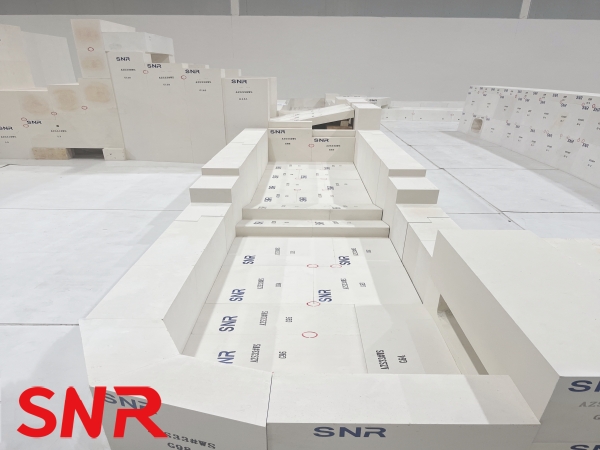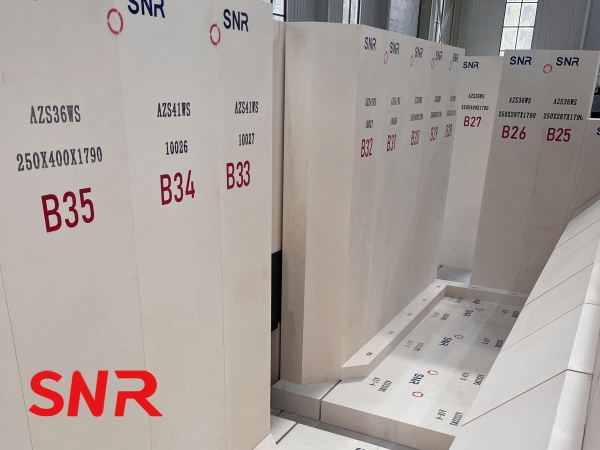
The glass industry, as a traditional high-energy-consuming sector, requires a large amount of energy during the melting process. The traditional air-assisted combustion method suffers from the nitrogen dilution effect, resulting in low thermal efficiency. The oxy-fuel combustion technology, by increasing the oxygen content of the combustion gas, has become the key path to break through the energy efficiency bottleneck of glass furnaces. This technology not only enhances the melting efficiency and improves the quality of glass, but also significantly reduces pollutant emissions, meeting the industrial transformation needs under the global "carbon neutrality" goals. Among them, the fused cast AZS blocks, as the key refractory material of glass furnaces, and the collaborative application of the oxy-fuel combustion technology play an important role in improving the performance of the furnaces. This article will systematically analyze the technical value and practical path of oxy-fuel combustion in glass furnaces from four dimensions: technical principle, application advantages, practical challenges, and innovation directions, and will focus on discussing the key role of fused cast AZS blocks.

1. Principle and Core Advantages of Oxy-fuel Combustion Technology
Oxy-fuel combustion technology is a key technology that optimizes the combustion process by increasing the oxygen concentration in the combustion-supporting gas. Its core lies in altering the composition of the combustion-supporting medium to overcome the limitations of traditional air combustion, achieving comprehensive goals of energy saving, efficiency enhancement, and emission reduction.
1.1 Technical Principle
The technical principle of oxy-fuel combustion is based on physical chemistry and thermodynamics, primarily functioning through the following three aspects:
(1)Reduction of Inert Gas Components
Traditional combustion uses air, in which approximately 78% is nitrogen, an inert gas. This nitrogen does not participate in the combustion reaction but absorbs a significant amount of reaction heat and is expelled as high-temperature flue gas, resulting in substantial heat loss. Oxy-fuel combustion fundamentally reduces this ineffective heat load by lowering the proportion of nitrogen.
(2)Increased Flame Temperature and Combustion Efficiency
According to the law of energy conservation, when the total heat released by the fuel remains constant, the mass of inert gas that needs to be heated is greatly reduced. This concentrates the energy more on heating the effective working medium, leading to a significant increase in flame temperature. Simultaneously, the higher oxygen partial pressure accelerates the reaction rate between fuel molecules and oxygen molecules, making combustion faster and more complete.
(3)Altered Heat Transfer Mechanism
In high-temperature industrial furnaces such as glass furnaces, radiation is the primary mode of heat transfer. The increase in flame temperature enhances its radiation intensity. Furthermore, the concentration of triatomic gases (such as CO₂ and H₂O) in the flue gas relatively increases. These gases have much stronger radiative capabilities than diatomic nitrogen, thereby significantly improving the radiative heat transfer efficiency from the flame to the material.
(4)Reduction in Flue Gas Volume
Due to the reduced nitrogen component, the total volume of flue gas produced after combustion decreases sharply, typically to between one-third and one-half of that under traditional air combustion.
1.2 Core Advantages
Based on the above principles, oxy-fuel combustion technology offers the following core advantages:
(1)Significant Energy Saving and Reduced Consumption
This is the most direct advantage. The sharp reduction in flue gas volume means a substantial decrease in exhaust heat loss, allowing more heat to be effectively retained within the furnace. Therefore, fuel consumption can be directly saved while achieving the same production load.
(2)Improved Production Efficiency and Product Quality
Higher flame temperatures and enhanced radiative heat transfer accelerate the melting and reaction rates of materials (such as glass batch), potentially increasing the furnace's production output. Meanwhile, a more stable and uniform high-temperature environment helps reduce product defects and improve the consistency of their physical and chemical properties.
(3)Source Emission Reduction and Improved Environmental Impact
Nitrogen Oxide Reduction: The generation of nitrogen oxides is closely related to the combustion temperature and nitrogen concentration. Oxy-fuel combustion reduces the partial pressure of nitrogen within the furnace and avoids the creation of local high-temperature zones, effectively suppressing the formation of thermal NOx at the source.
Carbon Dioxide Reduction: The reduction in fuel consumption directly leads to a decrease in total carbon dioxide emissions. Additionally, the reduced flue gas volume and increased carbon dioxide concentration lower the difficulty and cost for subsequent carbon capture and storage.
Reduction in Particulate Matter and Other Pollutants: More complete combustion reduces emissions of unburned carbon particles and soot.
(4)Optimized Equipment Operation and Structure
The reduction in flue gas volume can lessen erosion and corrosion to subsequent waste heat recovery systems and flues. In full oxy-fuel combustion, due to the extremely small flue gas volume, the large regenerators can even be eliminated, making the furnace structure more compact, reducing system air leakage, and leading to more stable operation.
In summary, the principle of oxy-fuel combustion technology lies in reshaping the combustion environment by "denitrification," and its core advantages are reflected in a series of interconnected benefits, including energy saving, quality improvement, emission reduction, and equipment optimization. This makes it a key pathway for technological upgrading and green transformation of industrial furnaces, especially glass furnaces.
2. Practical Approaches and Key Technologies in Glass Furnaces
2.1 Adaptation of Furnace Structure: From "Low Breast Wall" to "Gas Circulation Layer" Innovation
Traditional glass furnaces adopt a shorter mould wall design, resulting in a lack of a gas protection layer between the flame and the hearth top, and the high-temperature radiation generated by oxy-fuel combustion is prone to directly scorching the hearth. Modern solutions include:
►Crown Protection Layer Design: By optimizing the flow path of the flame and the supplementary combustion air, a low-temperature gas reflux layer is formed below the crown, blocking the transmission of high-temperature radiation.

►Burner Selection: Abandoning the traditional rotating oil mist nozzles, direct-burning nozzles, or oxygen-rich nozzles under the burner, direct-burning nozzles are adopted to avoid the swirling of rich oxygen air to the upper layer, causing local overheating. The direct-burning nozzles can increase the flame rigidity by 30% and the foam line stability by 20%.
2.2 Key Role of fused cast AZS blocks in Oxy-fuel Combustion Environments
Oxy-fuel combustion technology enhances energy efficiency and environmental benefits for the glass industry. However, this technology also creates more demanding furnace environments: higher flame temperatures, stronger radiant heat flux, and more reactive high-temperature atmospheres. Under such extreme conditions, fused cast AZS blocks are no longer ordinary refractory materials but a core barrier and functional material for ensuring the safe, stable, and efficient operation of the furnace.
Their key roles are mainly reflected in the following three aspects:
(1) Resisting High-Temperature Erosion and Maintaining Furnace Structure Integrity
The most direct challenge brought by oxy-fuel combustion is the increase in operating temperature. Fused cast AZS blocks, especially the ones used in critical parts, have become the preferred choice for addressing this challenge due to their unique crystal structure and extremely high refractoriness.
►High Melting Point and Anti-creep Property: The main crystal phases of fused cast AZS blocks (such as corundum, anatase zircon, mullite) have extremely high melting points, enabling them to maintain sufficient structural strength and volume stability at the high temperatures generated by oxygen-rich combustion, resisting softening deformation (creep) under long-term high temperatures and ensuring that the key dimensions of the furnace remain unchanged.
►Excellent Resistance to Glass Liquid Erosion: The core loss of the glass furnace is due to the chemical erosion of the glass liquid. The sillimanite phase in fused cast AZS blocks can react with the invading glass liquid, forming a high-viscosity reaction layer, effectively blocking the further penetration of erosion. Under oxy-fuel conditions, the melting rate may be higher, and the glass flow is stronger, making the resistance to erosion of the brick material more stringent. This characteristic of fused cast AZS blocks is crucial.
(2) Dealing with Atmosphere Changes and Chemical Erosion
Oxy-fuel combustion alters the chemical properties of the furnace atmosphere, presenting new chemical stability requirements for refractory materials.
►Dealing with High Alkali Vapor Environment: At higher temperatures, the volatile alkaline components in the raw materials are more intense. These alkaline vapors react with refractory materials, generating low-melting substances, causing the surface of the brick to "powder" or form cavities. High-quality fused cast AZS blocks have lower glass phase content and more stable crystal structures, effectively resisting this vapor-phase erosion.
►Adapting to High Water Vapor Pressure in Full Oxygen Combustion: In full oxygen combustion environments, the combustion products are mainly water vapor and carbon dioxide, with the furnace water vapor pressure being several times higher than that of air combustion. High-temperature water vapor accelerates the volatilization of certain refractory materials' silicon oxide and promotes material aging. Therefore, it is necessary to select fused cast AZS blocks produced by the oxidation method. These bricks have extremely low glass phase content and dense structure, minimizing the damage of water vapor to the brick and preventing early damage due to loose structure.
(3) As Key Functional Components, Ensuring Process Operation
Fused cast AZS blocks are not only "walls" in the furnace but also precisely designed "functional components", and their performance directly affects the thermal system and glass quality.
►Stability of the Upper Structure: The crown and chest wall of the furnace are directly exposed to the high-temperature flame and strong radiation generated by oxy-fuel combustion. Using fused cast AZS blocks with excellent high-temperature strength and creep resistance is the fundamental guarantee to prevent the crown top from sinking, deformation, or even collapse.
►Control of Glass Liquid Quality:The sidewall blocks and paving blocks in contact with the glass liquid have an erosion rate and uniformity that directly affect the quality of the glass. Uniform and slow erosion will not introduce excessive defects (such as stones and stripes) into the glass liquid. The uniform composition and dense structure of fused cast AZS blocks are the cornerstone for achieving this goal. Under the stronger convection brought by oxygen-rich combustion,high-quality fused cast sidewall blocks can effectively extend the service life of the furnace and stabilize the glass composition.
Conclusion:Synergistic evolution of materials and processes
To sum up, fused cast AZS blocks in an oxy-fuel combustion environment are not merely passively endured but are the key to actively ensuring the successful operation of the system. The superiority of the oxy-fuel combustion process largely depends on the high-temperature stability, chemical inertness, and structural reliability provided by high-performance fused cast AZS blocks.
With the promotion of oxy-fuel and full-oxygen combustion technologies, the technology of fused cast AZS blocks has also developed,such as the application of bricks with higher zirconium content, chromium-free bricks,and oxidation bricks. Therefore,when choosing and designing oxy-fuel combustion glass furnaces,scientifically selecting fused cast AZS blocks according to specific conditions (temperature, atmosphere, glass type) is one of the decisive steps to achieve technological upgrading and maximize economic benefits.
2.3 Fine Control of Process Parameters
Oxy-fuel combustion has a profound impact on the five stages of the glass melting process (preheating of raw materials,formation of silicate,clarification of glass liquid,homogenization,and cooling),and requires the following measures to achieve dynamic balance:
►Oxidation-Reduction State Regulation:The oxy-fuel environment enhances the oxidizing property of the materials, and the ratio of iron and carbon reducing agents in the raw materials needs to be adjusted to maintain the stability of the glass liquid's oxidation-reduction state. For example, in float glass production,the COD value (chemical oxygen demand) needs to be controlled within a specific range to prevent the glass from becoming yellowish or having more bubbles.
►Flame Characteristic Optimization:By adjusting the secondary air volume to control the flame length (2/3 of the furnace length is appropriate),avoid insufficient clarification temperature due to too short flames,or exacerbate the burn loss of the chest wall due to too long flames. At the same time,the AI system is used to collect nitrogen oxide concentration in real time,and dynamically adjust the fuel and air flow to achieve an emission concentration of ≤ 200mg/m³.
►Bubble Boundary and Throat Control: The clear bubble boundary should be located at 1/2 - 2/3 of the furnace length. By adjusting the distribution of the material pile to maintain the melting efficiency. The flow velocity at the throat is controlled at 6 - 8m/h,and fused cast AZS blocks are used to reduce erosion,with an annual erosion depth of ≤ 80mm.
2.4 Synergistic Application of Full Oxygen Combustion and Oxy-fuel Combustion
Full oxygen combustion (pure oxygen combustion) and oxygen-rich combustion (local oxygen enrichment) are not substitutes but complementary technologies:
Full oxygen combustion:Suitable for the production of precision products such as high borosilicate glass. The flame temperature is increased by 200°C,and nitrogen oxide emissions are reduced by 90%,but the oxygen production cost is higher.
Oxy-fuel combustion: Through local oxygen enrichment,the melting intensity in the hot spot area can be highlighted while reducing the overall oxygen production cost.
3. Practical Challenges and Innovation Breakthroughs
3.1 Enhancement of Fire Resistance Material Lifespan: Integration of Fused Cast AZS Blocks and Active Protection
The high-temperature environment generated by oxy-fuel combustion imposes higher requirements on fire-resistant materials. Traditional silica bricks tend to undergo crystal transformation and volume expansion above 1600°C, while fused cast AZS blocks, although having strong erosion resistance, may still experience micro-crack propagation under long-term high-temperature conditions. Therefore, the following measures are needed to achieve an increase in the lifespan of fire-resistant materials:

Optimization of Fused Cast AZS Blocks Quality: Strictly control the purity of the raw materials and the melting process of fused cast AZS blocks, reduce impurity content and crystal defects, and enhance their thermal shock resistance and erosion resistance.
Active Protection Technology: Install zirconium-blocking bricks or water-cooled copper sleeves at the arch top, combined with the high strength of fused cast AZS blocks, to form a dual guarantee of "material protection + structural protection", reducing the velocity non-uniformity coefficient (CV value) from >15% to <5%, significantly reducing erosion.
3.2 Integration of Intelligent Control System: Deep Fusion of Digital Twin and AI
Modern glass furnaces have achieved a leap from "experience control" to "intelligent control":
Digital Twin Model: Build a 1:1 virtual furnace, preview the effects of process adjustments, and reduce the cost of actual production trial and error. For example, a certain enterprise optimized the oxy-fuel supply strategy through digital twin technology, increasing the melting rate by 5%.
AI Defect Prediction: Based on data from 200+ sensors, it can provide early warning of bubbles and stone defects with 92% accuracy, and the linked feeding system can automatically correct errors.
DCS System Linkage: Achieve closed-loop control of temperature, pressure, and liquid level, with temperature fluctuations during switching ≤ 5°C/min, and the recovery time of furnace pressure ≤ 30 seconds.
3.3 Economic Breakthroughs in Pure Oxygen Combustion Systems
Although pure oxygen combustion offers significant energy savings (over 25%), the cost of oxygen production has long hindered its widespread adoption. In recent years, the cost of membrane separation oxygen production technology (90%-95% oxygen purity) has dropped to below 0.3 yuan/m³, making it more economical than cryogenic oxygen production (0.5-0.8 yuan/m³). Furthermore, combined with flue gas recirculation technology (recovering 70%-80% of the flue gas), oxygen consumption can be further reduced, making the application of pure oxygen combustion in large-scale float glass lines feasible.
4. Future Outlook: From Technological Optimization to Industrial Ecosystem Reconstruction
The deepening application of oxy-fuel combustion technology will drive the glass industry towards three transformations:
Low-carbonization: Through carbon capture and storage (CCS) technology, combined with the high concentration of CO₂ generated by oxy-fuel combustion, carbon neutrality can be achieved throughout the entire glass production process.

Intelligentization: 5G+ Industrial Internet technology will enable real-time collection and analysis of furnace operating data, building intelligent melting furnaces that are "self-sensing, self-determining, and self-optimizing."
Circularization: Waste heat generated by oxy-fuel combustion can be used for power generation or district heating, forming a circular economy model of "glass production-waste heat utilization-carbon capture." Furthermore, the recycling and reuse of fused cast AZS blocks will also become a research hotspot. Through processes such as crushing and remelting, resource recycling can be achieved, reducing production costs.
5. Conclusion
Oxy-fuel combustion technology, by reconstructing the kinetics and thermodynamics of the combustion process, provides a core solution for improving energy efficiency and achieving environmentally friendly transformation in the glass industry. As a key refractory material, fused cast AZS blocks play an irreplaceable role in oxy-fuel combustion furnaces due to their excellent corrosion resistance, high-temperature resistance, and thermal shock stability. This technology has formed a complete technical system, ranging from furnace structure adaptation to intelligent control integration, from refractory material innovation to breakthroughs in oxygen production technology. As the "dual carbon" goals are further promoted, the coordinated application of oxy-fuel combustion and fused cast AZS blocks will become a key driving force for the high-quality development of the glass industry, leading the industry into a new stage of green, intelligent, and efficient development.
Henan SNR Refractory Co., Ltd (SNR) focuses on producing high quality refractory materials.If you have any needs, please contact me.
 Email:moon@snrefractory.com
Email:moon@snrefractory.com
Web:www.snrefractory.com